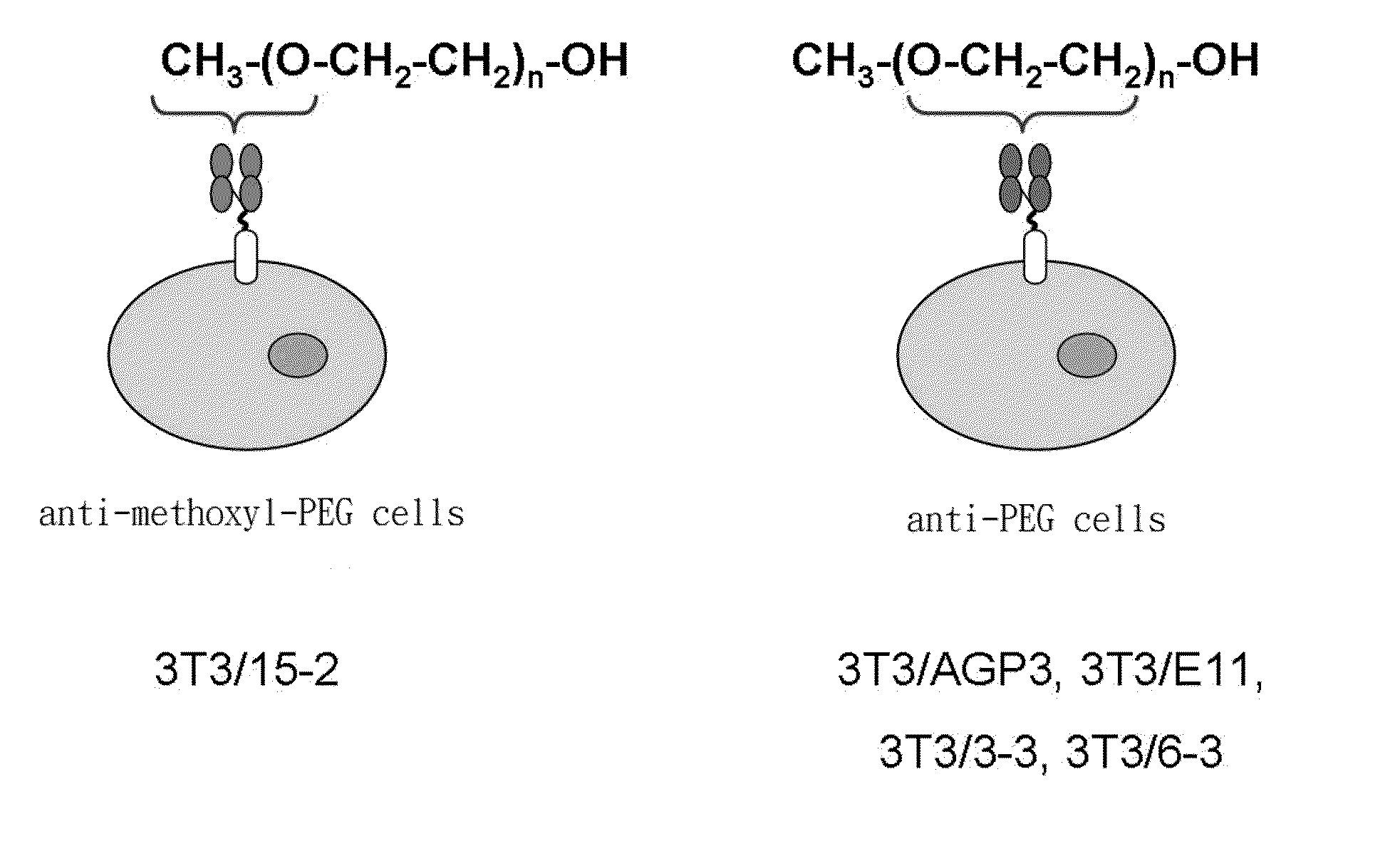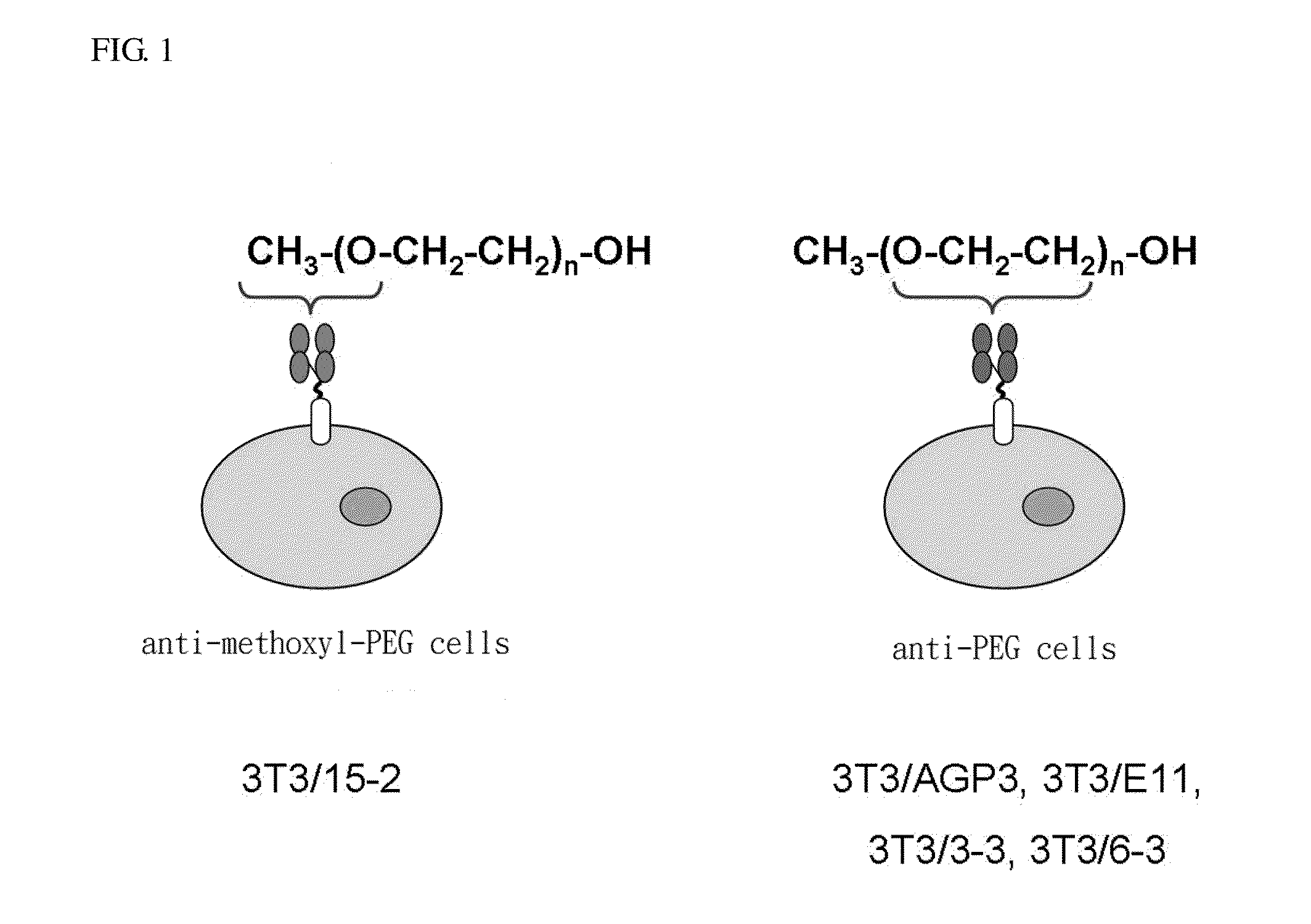Anti-polyethylene glycol antibody expressing cell quantify any free polyethylene glycol and polyethylene glycol-derivatized molecules
a polyethylene glycol and antibody technology, applied in the field of antipolyethylene glycol antibody expressing cell quan, can solve the problems of difficult detection process, inconvenient way to effectively quantify peg or peg-modified (pegylated) molecules in vivo, and insufficient precision
- Summary
- Abstract
- Description
- Claims
- Application Information
AI Technical Summary
Problems solved by technology
Method used
Image
Examples
example 1
[0016]Anti-PEG cells were used as a platform to establish a sandwich ELISA to quantify free PEG molecules and PEGylated molecules. 3T3 / AGP3 cells were seeded into a 96 wells plate before the PEG or PEGylated molecules were added, and then a biotinylated anti-PEG antibody (AGP4-Biotin) was used as a detecting antibody. Finally, color reagent, streptavidin-HRP, was added into the 96 wells plate. After adequate washing, the concentration of PEG or PEGylated molecules were known by observing the color intensity of the matrix coated on the 96 wells plate. With existence of serum, this method can quantify PEG molecules and PEGylated macromolecules (such as protein, fluorescent-nanoparticle and liposome) with PEG molecular weight 2,000, respectively, and the sensitivity is up to 100 ng / ml (5 nM), 10 ng / ml, 0.1 nM and 10 ng / ml, respectively. Therefore, this method can sensitively quantify all kinds of PEGylated molecules.
example 2
[0017]Anti-methoxyl-PEG cells were used as a platform to establish a sandwich ELISA to quantify all kinds of free methoxyl-PEG molecules. 3T3 / 15-2 cells were seeded into a 96 wells plate. After that, the methoxyl-PEG was added as an analyte, and then a biotinylated anti-PEG antibody (AGP4-Biotin) was used as a detecting antibody. Finally, streptavidin-HRP was added into the 96 wells plate. After adequate washing, the concentration of methoxyl-PEG was known by observing the color intensity of the matrix coated on the 96 wells plate. With existence of serum, this method can quantify all kinds of free methoxyl-PEG molecules (CH3O-PEG2K and CH3O-PEG5K), and the sensitivity was better than using 3T3 / AGP3 platform. Therefore, the sandwich ELISA method using 3T3 / 15-2 platform can sensitively quantify all kinds of methoxyl-PEG molecules.
example 3
[0018]Anti-PEG cells were used as a platform to establish a competitive ELISA to quantify free PEG molecules. 3T3 / AGP cells were seeded into a 96 wells plate, and a fixed amount of the biotinylated-PEG molecule (PEG-Biotin) was mixed with the analyte (free PEG molecule) by equal volume (1:1) to form a mixture, and then the mixture was added into the 96 wells plate. Finally, streptavidin-HRP was added into the 96 wells plate. After adequate washing, the concentration of free PEG molecule can be known by observing the color intensity of the matrix coated on the 96 wells plate. With existence of 40% serum, this method can quantify PEG molecules with molecular weight 20,000 to 2,000 (PEG20K, PEG10K, PEG5K and PEG2K), and the sensitivity is up to 3.7 ng / ml, 3.7 ng / ml, 14.6 ng / ml and 58.6 ng / ml, respectively. Therefore, this platform can sensitively quantify many kinds of free PEG molecules.
[0019]While the invention has been described and exemplified in sufficient detail for those skilled...
PUM
| Property | Measurement | Unit |
|---|---|---|
| Color | aaaaa | aaaaa |
| Concentration | aaaaa | aaaaa |
Abstract
Description
Claims
Application Information
 Login to View More
Login to View More - R&D
- Intellectual Property
- Life Sciences
- Materials
- Tech Scout
- Unparalleled Data Quality
- Higher Quality Content
- 60% Fewer Hallucinations
Browse by: Latest US Patents, China's latest patents, Technical Efficacy Thesaurus, Application Domain, Technology Topic, Popular Technical Reports.
© 2025 PatSnap. All rights reserved.Legal|Privacy policy|Modern Slavery Act Transparency Statement|Sitemap|About US| Contact US: help@patsnap.com



